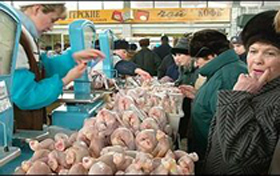Poultry prices in Russia rise after ban

Russian poultry prices have risen as much as 20 percent since health officials banned US imports Jan. 1, raising concern among domestic producers that they won’t be able to meet demand.
Wholesale prices have reached about 70 rubles ($2.36) per kilogram, from about 58 rubles at the end of December, said Yevgeny Kogan, chairman of the Food Trade Group, which supplies meat and produce to supermarkets.
Russia on Dec. 30 slashed the allowable chlorine limit on imported poultry to 50 milligrams per kilogram from 200 milligrams starting Jan. 1, essentially banning chicken meat from the United States, where chlorine is the primary disinfectant. Russia is the largest export market for US poultry producers, which had about 22 percent of the market last year.
“This price growth isn’t good,” Kogan said. “Poultry used to be the cheapest protein in Russia, consumed mostly by low-income individuals. So any price increase might be harmful for sales volumes.”
Russia consumed some 3.5 million tons of poultry in 2009, about 900,000 of which was imported, mostly from the United States, according to the Association of Russian Poultry Market Operators. “The U.S. may end up supplying nothing this year because of the ban,” the group’s head Andrei Teriokhin said. US food officials will fly to Moscow next week to discuss the ban.
Source: The Moscow Times













